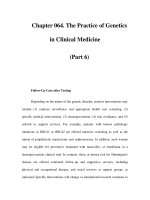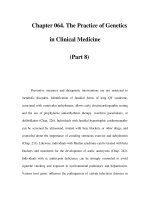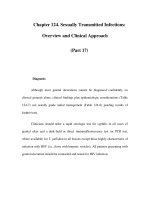Chapter 124. Sexually Transmitted Infections: Overview and Clinical Approach (Part 9) pot
Bạn đang xem bản rút gọn của tài liệu. Xem và tải ngay bản đầy đủ của tài liệu tại đây (79.05 KB, 5 trang )
Chapter 124. Sexually Transmitted Infections:
Overview and Clinical Approach
(Part 9)
Bacterial Vaginosis
This syndrome (formerly termed nonspecific vaginitis, Haemophilus
vaginitis, anaerobic vaginitis, or Gardnerella-associated vaginal discharge) is
characterized by symptoms of vaginal malodor and a slightly to moderately
increased white discharge, which appears homogeneous, is low in viscosity, and
evenly coats the vaginal mucosa. An interesting observation is that new genital
HPV infection in young women is associated with increased subsequent risk of
developing bacterial vaginosis. Other risk factors include multiple sexual partners
and recent intercourse with a new partner, but metronidazole treatment of male
partners has not reduced the rate of recurrence among affected women.
Among women with bacterial vaginosis, culture of vaginal fluid has shown
markedly increased prevalences and concentrations of G. vaginalis, Mycoplasma
hominis, and several anaerobic bacteria [e.g., Mobiluncus spp., Prevotella spp.
(formerly Bacteroides spp.), and some Peptostreptococcus spp.] as well as an
absence of hydrogen peroxide–producing Lactobacillus spp., which constitute
most of the normal vaginal flora and perhaps help protect against certain cervical
and vaginal infections. The use of broad-range polymerase chain reaction (PCR)
amplification of 16S rDNA in vaginal fluid, with subsequent identification of
specific bacterial species by various methods, has documented an even greater and
unexpected bacterial diversity, including several unique species not previously
cultivated [e.g., three species in the order Clostridiales that appear to be specific
for bacterial vaginosis (Fig. 124-2)]. Also detected are DNA sequences related to
Atopobium vaginae, an organism that is strongly associated with bacterial
vaginosis, is resistant to metronidazole, and is associated with recurrent bacterial
vaginosis after metronidazole treatment. Other species newly implicated in
bacterial vaginosis include Lactobacillus iners, Megasphaera, Leptotrichia,
Eggerthella, and Dialister.
Figure 124-2
Broad-
range PCR amplification of 16S rDNA in vaginal fluid from a
woman with bacterial vaginosis shows a f
ield of bacteria hybridizing with
probes for bacterial vaginosis–
associated bacterium 1 (BVAB1, visible as a thin,
curved green rod) and for Mobiluncus (red). The inset shows that Mobiluncus
(red) is larger than BVAB1 (green) but that the two have a simila
r morphology
(curved rod). (Reprinted with permission from DN Fredricks et al.)
Bacterial vaginosis is conventionally diagnosed clinically with the Amsel
criteria, which include any three of the following four clinical abnormalities: (1)
objective signs of increased white homogeneous vaginal discharge; (2) a vaginal
discharge pH of >4.5; (3) liberation of a distinct fishy odor (attributable to volatile
amines such as trimethylamine) immediately after vaginal secretions are mixed
with a 10% solution of KOH; and (4) microscopic demonstration of "clue cells"
(vaginal epithelial cells coated with coccobacillary organisms, which have a
granular appearance and indistinct borders; Fig. 124-3) on a wet mount prepared
by mixing vaginal secretions with normal saline in a ratio of ~1:1.
Figure 124-3
Wet mount of vaginal fluid
showing typical clue cells from a woman with
bacterial vaginosis. Note the obscured epithelial ce
ll margins and the granular
appearance attributable to many adherent bacteria (x 400). [
Photograph provided
by Lorna K. Rabe, reprinted with permission from S Hillier et al, in KK Holmes et
al (eds). Sexually Transmitted Diseases, 4th ed. New York, McGraw-Hill, 2008.]









